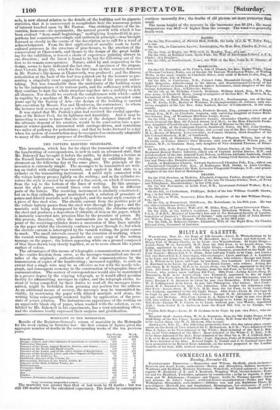THE COPYING ELECTRIC TELEGRAPH.
This invention, which has for its object the transmission of copies of the handwriting of correspondents, is now in such an advanced state, that Mr. Bakewell has brought it before the public, by delivering a lecture at the Russell Institution on Tuesday evening, and by exhibiting the in- strument on the following day at the seine place. The principle of the invention is extremely simple. The messages to be transmitted are writ- ten on tinfoil with sealing-wax varnish, and applied in that state to a cylinder on the transmitting instrument. A metal style connected with the voltaic battery presses lightly on the writing; and as the cylinder re- volves the style is carried by means of a fine screw, on which it traverses, from the top to the bottom of the lines of writing. By this arrange- ment the style passes several times over each line, but in different parts of the letters. The receiving instrument is similarly constructed; but on to that cylinder, paper moistened with a solution of prussiate of potass and diluted muriatic acid is applied; and the metal style consists of a piece of fine steel wire. The electric current from the positive pole of the voltaic battery passes from the steel wire through the paper ; and the muriatic acid being decomposed by the electricity, the chlorine attacks the steel and produces a deposition of chloride of iron on the paper, which is instantly converted into prussian blue by the prussiate of potass. By this process, therefore, when the instruments are in motion, the steel point of the receiving-cylinder draws a succession of blue lines spirally on the paper whilst the electricity continues to pass through it; but when the electric current is interrupted by the varnish writing, the point ceases to mark. The small intervals caused by the cessation of marking, where the varnish writing interposes, produces an exact copy of the written message on the paper.; the letters appearing white on a ground composed of blue lines drawn very closely together, so as to seem almost like a plain surface of colour.
The advantages of this means of telegraphic communication were stated to be—entire freedom from error, as the messages transmitted are facsi- miles of the originals ; authentication of the communications by the transmission of copies of the handwriting; increased rapidity, to such an extent that a single wire may be as effective as ten with the needle tele- graph, and aonsequent economy in the construction of telegraphic lines of communication. The secrecy of correspondence would also be maintained in a greater degree by the copying telegraph, as it would afford peculiar facility for tilinsmitting messages in cipher, and the telegraph clerks, in- stead of being compelled by their duties to read all the messages trans- mitted, might be forbidden from perusing any portion but the address. As an additional means of secrecy, the messages may be transmitted in- visibly, by moistening the paper with diluted muriatic acid alone, the writing being subsequently rendered legible by application of the prus- siate of potass solution. The instantaneous appearance of the writing on an apparently blank slip of paper, when washed with the solution, as ex- hibited by Mr. Bakewell in his experiments, has a very astonishing effect, and the audience loudly expressed their surprise and gratification.


























 Previous page
Previous page